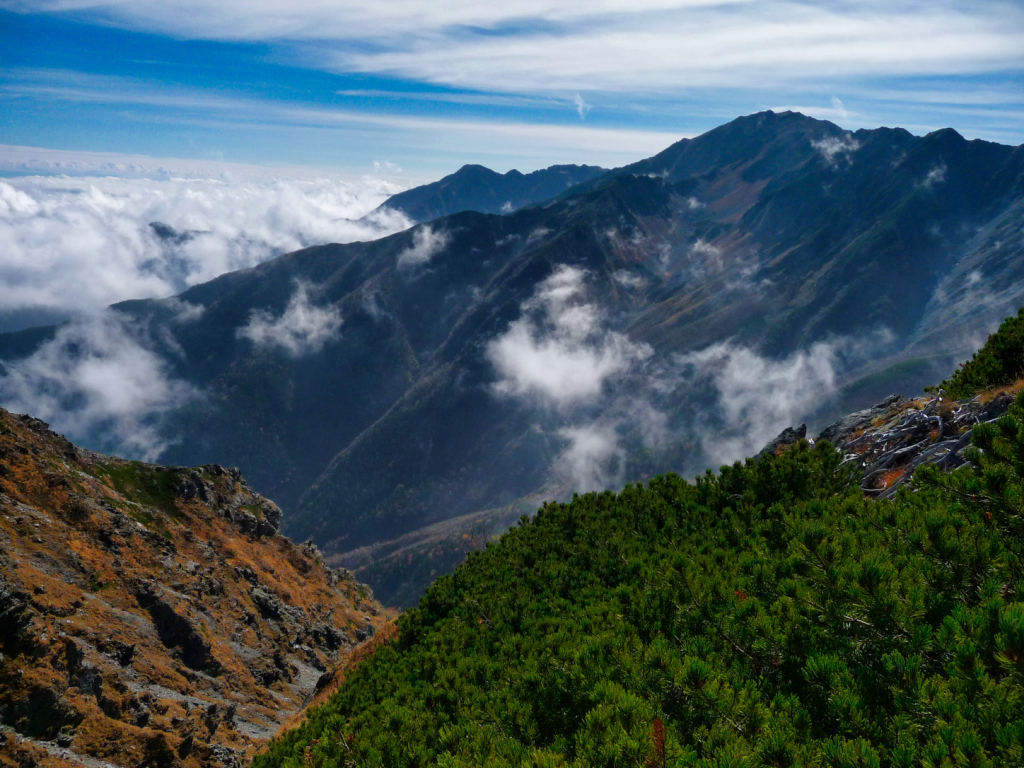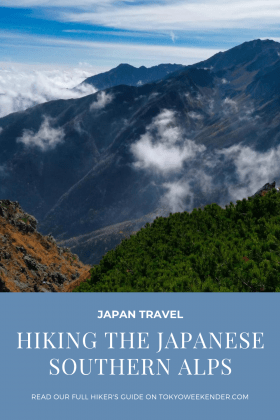When the English archeologist William Gowland saw the major mountain chain in the middle of Honshu he thought they resembled the European Alps so he named them accordingly. Later, English missionary Reverend Walter Weston agreed with Gowland and popularized the name the Japanese Alps.
Today, Japan’s most majestic mountain range is divided into the Northern Alps, the Middle Alps and the Southern Alps. Within this mountain chain there are some of Japan’s highest mountains and some of its most famous reside in the Southern Alps, including the Yatsugatake Mountains and Mount Warusawa (3,141m), the highest of the three Arakawa Mountains.
The Southern Alps cover a vast area in Nagano, Yamanashi and Shizuoka prefectures. The Minami Alps National Park is the recommended place to access the nature and adventure. In this park you can mountain climb, casually hike, watch wildlife and just take in the awesomeness.

Minami Alps National Park
In Yamanashi on the outskirts of the capital city, Kofu, lies the UNESCO Minami Alps Biosphere Reserve. One of 10 UNESCO Biospheres Reserves within Japan, the designation comes with three objectives as dictated by UNESCO: first, having an area where humans can prosper from nature; second, where humans can interact with nature for pleasure and educational purposes, and third, a natural area that can remain wild and nature can flourish.
Other than buses and taxis, no vehicles are allowed into the reserve, thus nature is abundant. Wildlife such as ptarmigans, Japanese serow, deer, monkeys and bears all thrive. In spring, flowers blanket the flora of the park. Nature alone is enough of a reason to visit the park. An even greater reason to visit is the dynamic mountains.
This Minami Alps National Park harbors Japan’s second- and third-highest mountains – Mount Kitadake (3,193m) and Mount Ainodake (3,190m), respectively. Just barely in the top 20 are Mount Senjogatake (3,033m) and Mount Notoridake (3,026m). Senjogatake is called the Queen of the Southern Alps and Notoridake received its name from local lore as every June a bird-like shape appears on the eastern side of the mountain signifying a change in the agricultural calendar.
While not as high, equally noteworthy are Mount Kaikomagatake (2,967m), which is a pyramid-shaped mountain, and the three peaks of Houou Sanzan, which comprises of Mount Yakushigatake (2,780m), Mount Kannongatake (2,841m) and Mount Jizougatake (2,764m).

Hiking in Japan’s Southern Alps
As a result, hiking and mountain climbing abound. Trails can be steep, but meander in and out of forests that teem with the sounds of birds and other critters. Reach towering peaks that offer incredible views of the Southern Alps, as well as Mount Fuji. Trails can go for kilometers and a person can hike for hours or even days. On the other hand there are shorter hikes that allow less serious hikers to see and enjoy the amazing views and landscape.
While Kitadake is the most popular to climb, Ainodake is an exhilarating hike that traverses across a long ridgeline. Not as high, but still offering impressive views and challenging (labeled as “difficult”) climbs, are Mount Asayomine (2,799m) and Mount Sentoboshiyama (2,139m). Nowhere as difficult is the hour-long hike to Yashajin Pass (1,770) and its views of all major peaks.
There are two popular hiking routes: the Hirogawara Trailhead, which traverses the major peaks of Kitadake, Ainodake and Notoridake as well as a few lower mountains, and the Yashajin Trailhead, which covers the remaining peaks. Just before you go hiking be sure to fill out the form for the authorities in case there is an emergency (registration forms available here – Japanese only). In 2021, the hiking season is from July 25 to November 3, making ample time to conquer these mountains. Such a visit will make you realize why Gowland and Weston loved the Japanese Alps.
How to Get to the Japanese Southern Alps
From Shinjuku take a bus or train to Kofu. The bus runs along the Chuo Expressway and takes two hours (¥2,200). The Azusa or Kaiji Express trains run along the Chuo Train Line and take 90 minutes (¥3,890). From Kofu Station take the Minami Alps Tozan Bus to either Ashiyasu Parking (takes one hour and costs ¥1,090) or Hirogawara Station (takes two hours and costs ¥1,950). Due to the Covid-19 pandemic, make sure to check the local bus schedule in advance.
More hiking guides:










